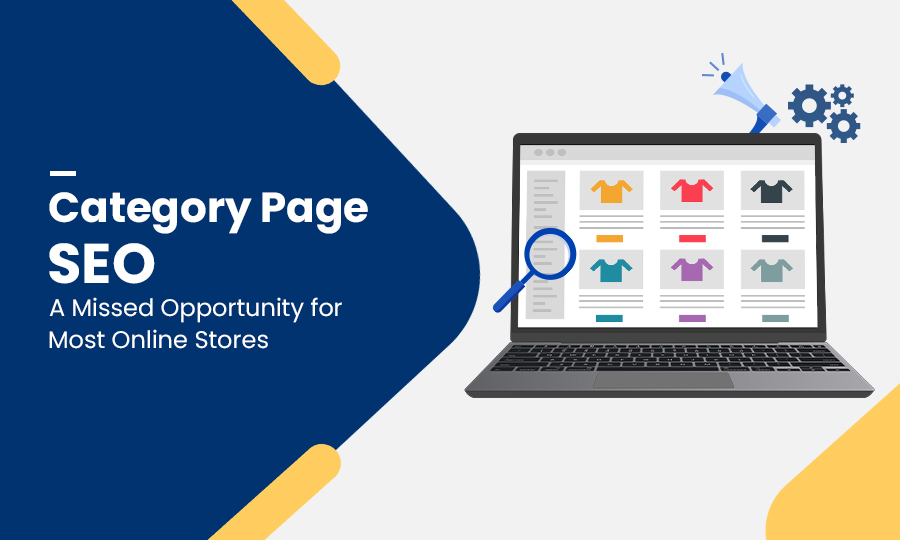In today’s competitive e-commerce world, category pages act as a gateway for discovery. But they are not utilized properly when it comes to SEO strategies. These pages not only improve user navigation but also have a great potential to attract organic traffic. Meanwhile, a large number of online stores often fail to optimize category pages. As a result, they often fail to grab opportunities to boost their search engine rankings and maximize conversions.
According to research conducted by Jill Kocher Brown, optimized category pages increase substantial traffic up to 413% compared to product pages. Besides, they also rank 19% more keywords compared to product pages. It underscores the overall significance of focusing on category page SEO to gain a wider audience and also improve sales.
In this blog, we will discuss the importance of category page SEO and how it opens up opportunities for e-commerce businesses. We will discuss how to optimize your e-commerce category pages for search engines to get the desired outcomes.
What are Category Pages SEO?
When it comes to category page SEO, it includes the overall process of optimizing both the eCommerce category and subcategory pages. It helps in improving visibility in search engines and thus catches more relevant organic traffic. Category pages are completely different from product pages and focus mainly on high-intent and broader keywords such as “best laptops under 500” or “men’s jackets”.
A well optimized category page includes various important factors such as meta descriptions, keyword-rich titles, clear headings, descriptive content, strategic internal linking, and more. You need to opt for e-commerce category page SEO that can improve ranking with an improved user experience. It leads to maximum engagement and conversions.
Why is Category Page SEO Important?
Category pages are crucial for eCommerce navigation. Optimizing them strategically unlocks numerous advantages, often extending beyond higher rankings. Explore the top benefits below:
- Boost Targeted Organic Traffic
Ensure category pages naturally target mid-funnel, high-volume keywords like “laptops under $1000” or “best men’s running shoes.” These searches indicate a clear intent to browse and compare. Elements such as optimized category descriptions, titles, and metadata help search engines interpret content and drive qualified organic traffic that converts, rather than drawing generic visitors.
- Boost Indexation and Crawlability
Search engines rely mainly on accessible and structured category pages to crawl and index your website in the most effective way. With a perfectly optimized category page accompanied by breadcrumbs, clear navigation, canonical tags, and more.
These work effectively to offer a clear direction to crawl deep into the product catalog. It works well for the prevention of wasted crawl budget on thin or duplicate web pages, which ensures your valuable category page’s content is indexed and thus ensures its visibility in search outcomes.
- Improve User Experience
Another most promising advantage of a perfect category page is that it makes the entire shopping process smooth and highly intuitive. You can easily guide users for shopping by adding various important factors such as filters, headings, short buying guides, etc.
These help users find what they are looking for. Make sure you include relevant visual content and FAQs that can improve the experience further. An improved UX not only minimizes bounce rates but also reflects search engines’ interest in your pages, offering value, which indirectly reflects value.
- Improve Topical Authority
You need to know that category pages act as thematic hubs across specific product types. Be it adding internal links to related products, keyword-rich content, or contextual guides, adding these helps you reflect a great depth of knowledge on a specific topic. With time, it develops a great topic authority for search engines and thus helps your store gain a competitive edge against established brands and marketplaces.
- Increase Conversion Potential
Category pages have a direct involvement in the funnel. Those visitors who land on this page seem they be already prepared to buy and explore the right options before they commit. You can easily convert your category traffic into revenue through category page optimization with quality images, persuasive copy, and clear CTAs. A powerful SEO for these image pages indicates getting not only search traffic but also qualified buyers.
What are the Differences Between a Category Page and a Product Page?
We explain here some of the key differences between the category page and the product page briefly. Let’s go through the following table to understand the same.
| Aspect | Category Page | Product Page |
| Purpose | The major purpose of a category page is to group many related products together. | It reflects an individual product with detailed information. |
| SEO Focus | It targets mainly border and those of high-intent and relevant keywords like “Top laptops under $500 | It targets mainly purchase-specific or long-tail and relevant keywords. For instance, like “Dell Inspiron 15 3000 specs.” |
| Content | In general, it includes filters, product listings, FAQs, and short descriptions. | It includes various product details like specifications, features, images, and reviews. |
| User Content | It allows users to browse and also make an effective comparison of different options within an individual category. | It helps users in determining and also deciding on buying one particular product. |
| Conversion Role | It’s mid-funnel that guides users closer when it comes to choosing a product. | Bottom funnel helps you encourage the final decision of purchase. |
| Internal Linking | It links a large number of product pages and also several subcategories. | You need to link back to related products or parent categories. |
| Structure | It works as a navigation hub in the site hierarchy. | It works as an endpoint page focused mainly on transactions. |
Proven Tips to Optimize Category Pages to Unlock the Missed Opportunities
Now, you have enough information regarding category pages – it’s the right time to discuss several tips that are useful for optimization of category pages. We will discuss each tip in detail.
- Use the Right Category
When it comes to category page SEO strategy for any eCommerce store, it’s not only about the matter of search engine optimization. It’s also about the way you structure categories. The first and most important thing you need to do is to organize your products better into logical categories that make sense to users. Be it poor layout or navigation, these discourage users from leaving your e-commerce stores.
So, the most important thing you can do is to group your products into vast categories that are as follows.
- Men’s clothes
- Women’s clothes
- Children’s clothes
- And more
After doing it properly, you can now break every category down further. Eventually, you need to create specific long-tail category pages such as “women’s yoga leggings”.
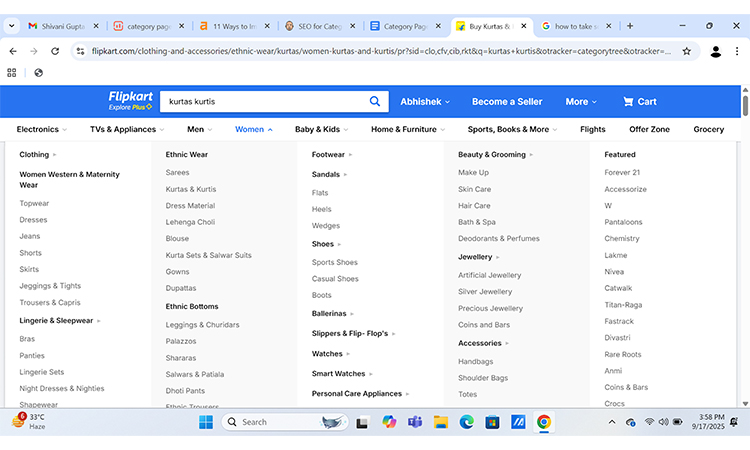
In the above, we have taken a screenshot of a leading e-commerce market player named Flipkart to show how to break down products into multiple categories and subcategories.
- Add Helpful Content
Helpful content serves its actual purpose to encourage users to make the right buying decision. For instance, if your website has a category named “Women’s T-shirts”. You should avoid writing the same, as it would not help you in any way. Instead of this, you can add valuable content in this scenario that will be more related to answering queries, as follows.
- How have you sourced your raw materials?
- Do you have your own manufacturing unit?
- Why did you select any particular materials?
- What is the most trending style?
You can answer the main pain points below the H1, which is approximately 30 to 60 words. You can add further information below the page, either in the form of an FAQ section or a content block.
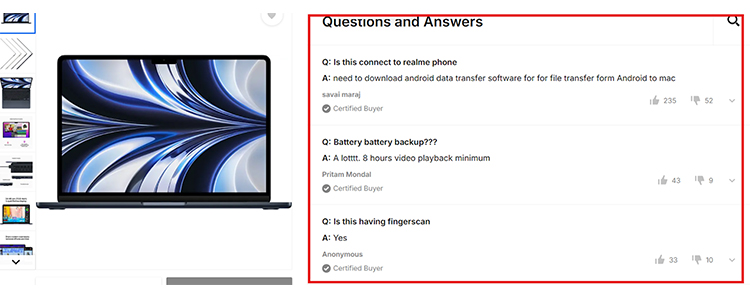
To help you understand better, we have shown FAQs related to laptops.
- Use Category URLs to Build a Hierarchy
Well, it’s indeed quite challenging when it comes to getting your pages indexed by Google. Meanwhile, you will be able to resolve or prevent these issues better with an organized URL structure. You need to take into account that an eCommerce hierarchy is highly important for numerous reasons.
- It enables search engines to get aware of the complete structure of your website.
- It boosts the usability and UX of your website, which maximizes customer satisfaction. You will be able to improve category pages for SEO and make it convenient for users to discover products easily.
In addition, an inferior quality structure increases the possibility for Google to miss content, or it tends to retrieve even the same pages many times. For a well-known clothing store, a hierarchical URL structure should appear something like this.
- fashionstore.com/women
- fashionstore.com/women/attire
- fashionstore.com/women/nightdress
No matter what structure you wish to use, you need to ensure that you keep URLs clean by avoiding dates, numbers, and special characters. Apart from this, you also need to ensure that your URLs are clean by avoiding dates, numbers, special characters, and more. Apart from this, you need to avoid going in-depth and also three or four different subcategories. Google faces huge difficulty when it comes to crawling your entire website.
- Create a Consistent Layout
When potential customers access your website, you wish to ensure they get a positive experience. It converts them into paying customers. Meanwhile, research already revealed that customers are not always satisfied with an improved online experience.
So, now the question is, what tactics will you follow to boost customer satisfaction? Of course, you can do the same by creating a consistent layout across different category pages.
When every category page is structured the same, it’s indeed convenient for shoppers to navigate your website fast. They are aware of what to expect, where to search for items, how to filter product options, and more.
How to Create a Consistent Layout?
Let’s understand several important ways of creating a consistent layout in the most effective way.
- Choose the right basic color scheme.
- Use the same footer and header consistently on every page of the website to craft a recognizable branding for your store. It helps you improve navigation as well.
- You should always stick to the same fonts across your website.
- It’s important to organize your products consistently across all your website pages.
- You should always place call-to-actions (CTAs) in the same place on every page of your website.
- Add Product Reviews
Including product reviews is a must-have activity for your product pages. The main reason is that they act as social proof by including customer testimonials on your category pages and thus maximize conversion.
Researches already reveal that ratings and reviews are one of the top factors that impact everything, be it above price, purchase decisions, recommendations, shipping, and more from friends and family. They don’t spoil the flow of your category page in either way.
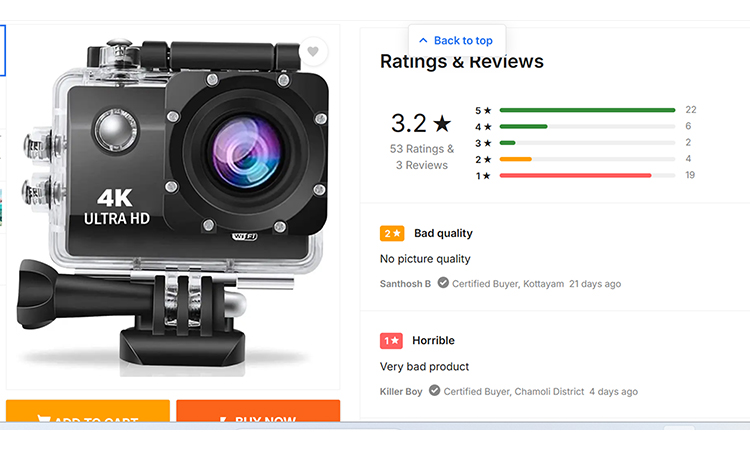
- Optimize Your Meta Data and Title Tags
Metadata means both category title tags and meta descriptions are important part of category page SEO. For on-page SEO, category title tags are something that holds great importance. They let search engines understand what your page is all about. It determines the title of your page in SERPs, which is what users visualize when deciding which website to visit.
How to Write a Good Title Tag?
A perfectly written title tag should meet the following important criteria.
- It should be appropriate to the page content.
- It should be keyword-rich and descriptive.
- It should be short and crisp and written under 60 characters.
Meta descriptions offer search engines a brief summary of your image and also persuade searchers to click through to your website.
How to Create the Right Meta Descriptions?
To create meta descriptions, you need to follow the following conditions.
- Make sure your meta description is brief. It should be less than 155 characters.
- Use appropriate keyword-improved category descriptions. But avoid keyword stuffing.
- Update your meta description on a daily basis.

In the above, you can see the best examples of both “title tag” and “meta description”.
- Answer User Questions
Answering users’ questions is another important and effective way to improve category pages for SEO. So, you should never ignore it, irrespective of your plan. Make sure you answer every question that appears in the FAQ section.
This is indeed a great way of creating trust and thus boosting conversion rates, especially if you answer genuine questions that most shoppers ask the customer support team. It gives you a brilliant opportunity to rank in the section popularly known as the “People Also Asked” section of Google.
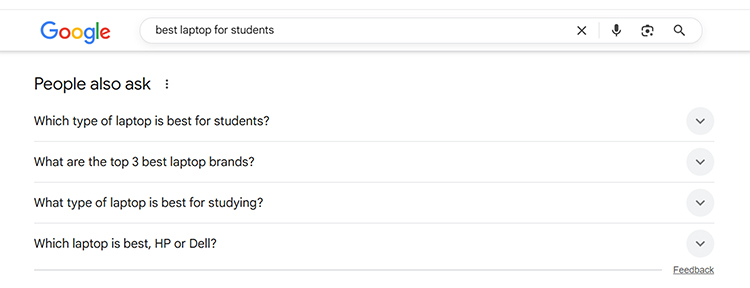
The above image shows some of the popular questions that users always ask while searching for “best laptop for students”.
- Pagination and Linking to Products
The core purpose of categories is to link to products. But, you might be seeking to know how to do it better, right? Well, you have to do nothing but consider a couple of nuances.
Link Category Pages to Popular Products
If you own a large store, it’s always a good idea to focus on linking to popular products, especially compared to linking all products with pagination.
This is indeed quite useful for users and also helps you focus on PageRank for those URLs, which improve how perfectly they rank.
Doing the same is indeed a great option compared to linking to a large number of products. The reason is that it results in the popular traffic-driving products that obtain less PageRank and also rank worse.
- Be Concise with your Copy
The most common mistake that eCommerce store owners commit is going overboard with the higher amount of copy on their pages. If you also do the same, you need to avoid doing the same, as it distracts shoppers. It’s highly important for you to focus on creating a concise copy with only a few hundred words.
Make sure your copy includes the following important points.
- Compelling headline
- A brief introduction
- A bold call to action
- Salient information
These are indeed useful for shoppers to make a purchase. You need to always avoid talking about the history of your product or the market in general, which offers actionable advice. It moves them further down the purchase funnel. It includes the following crucial information.
- USP (Unique Selling Points) of products
- How do you select products?
- The way you source materials
The most important thing you can do is to make your content as scannable as you can. Let’s have a good example below.

- Focus on User Experience
No matter what, user experience matters the most. So, you need to make every page of your website deliver a fabulous user experience consistently. It indeed keeps great importance, especially for category pages, which are also popular as core landing pages.
How to Improve the UX of Category Pages?
Well, to improve the user experience of your category page, you need to consider the following important tips and tricks.
- It’s highly important to improve the loading speed of your page. You need to take into account that category pages are image-heavy. It’s advisable to use your images and also use a content delivery network (CDN), in case it’s necessary.
- Make sure you use descriptive, eye-catching, and clear headlines and subheadings. Doing the same allows visitors to quickly understand what they expect on the page and also whether it’s appropriate based on their core requirements.
- You need to ensure that your page is easy to navigate and highly organized. It’s advisable to use sectioning, sorting options, helpful filters, etc., clearly. It lets visitors discover easily what they are looking for.
- It’s a great idea to include the most appropriate product details like colors, examples, volume, sizes, and more.
- You can implement faceted navigation to make large category pages while ensuring they’re highly browsable.
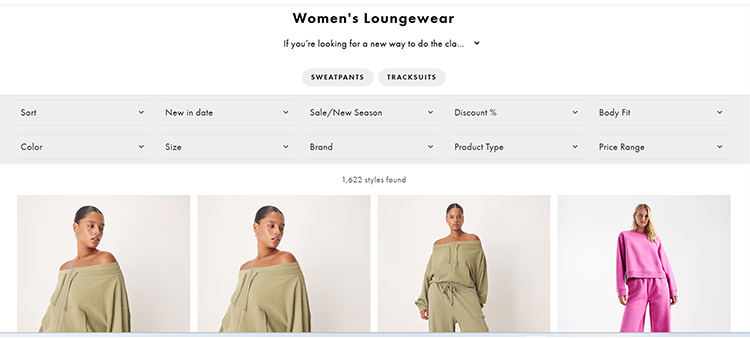
The above image clearly shows the best example of the large faceted navigation from a reputable store like ASOS. It has a number of ‘women’s loungewear’ items for sale. The above filters are necessary to allow customers to customize their searches.
- Link Categories Internally
You need to always take into account that category pages and internal linking are highly important. These pages include a number of internal links even by default. You need to take into account that every product you link to is mainly to an internal link.
But you should never ignore the actual benefits of linking to other category pages as well. It’s crucial to craft some “popular categories” or even you can create “editor’s picks” as well within your page layout to offer a space to manually link to many other relevant categories.
Breadcrumbs provide another important way of linking various category pages with the rest of the website. These indeed make it convenient for search engines to index your content and also help users navigate your website. The following is the best example that reflects the internal linking.

- Use Compelling Images
According to research, 90% of shoppers consider photo quality as an important factor when making the right purchasing decision. Therefore, it’s highly important to boost your eCommerce category page search engine optimization by including top-quality images as much as possible.
How to Create Compelling Images?
To create attractive images, you need to consider the following important tips.
- You need to reflect products in context, or also in use.
- You need to ensure thumbnail and feature images are eye-catching and engaging.
- You need to capture images from different angles.
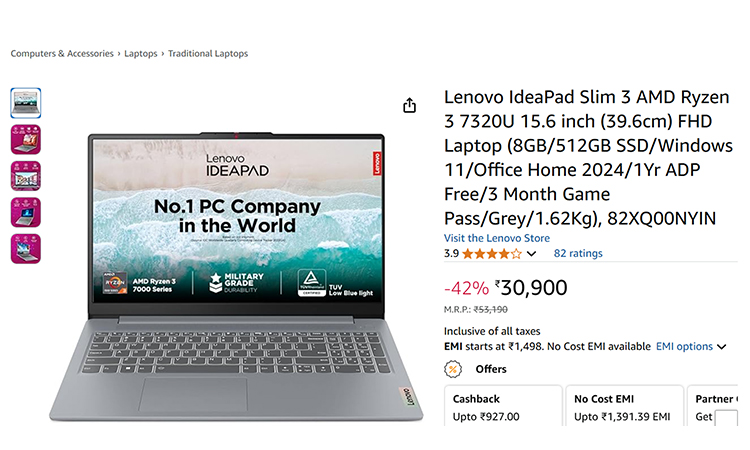
To get a clear view, you need to hover over every image to get an attractive in-context shot. It helps you know what a laptop looks like. You should never forget to use alt text for your images. It’s important to understand that search engines can’t visualize images. But you can help search engines understand images by adding alt texts.
- Always Use Structured Data
When it comes to structured data, it’s considered to be a standardized format that can easily classify some or all content of pages. You are indeed versed in different types of structured data, including local business structured data and rich snippets. You will be able to use varieties of structured data you will be able to use to boost your eCommerce category page SEO. These include the following;
- Breadcrumbs
- FAQs
- ItemList
- Review
- Store
When you add structured data, it boosts how your website appears in search results.
- Focus on Conversion Rate Optimization (CRO)
Conversion rate optimization involves testing and changing the impact of multiple on-page elements based on it while improving category page conversion rates. You need to test the following important factors;
- Headings
- Images
- Body copy
- Colors
- Calls to action
- Product review placement
You should never stop when you witness an improvement. It indeed doesn’t matter how many conversions features you need to add to your category page.
Mistakes to Avoid for Category Page SEO
You need to understand that category pages include huge SEO potential. Meanwhile, a large number of online stores fail to improve their overall value mainly due to certain mistakes. These mistakes minimize visibility in search engines, apart from weakening conversions and experience. Let’s understand some of the common mistakes.
- Avoiding Search Intent
One of the major mistakes that businesses often commit is to ignore what users actually look for when they come to the landing page. For instance, when users search for “women’s formal shirts”, they expect a great collection of shirts – not an irrelevant product or any generic category description.
Therefore, when you fail to meet search intent, it causes an improved bounce rate and lower rankings. To ignore, you need to align your category content perfectly and also product assortments with the actual requirements of users.
- Using Thin or Duplicate Content
A large number of stores often publish category pages with either no or even little descriptive text, which rely mainly on product grids. Meanwhile, others copy content directly from manufacturers or also reuse the same descriptions across multiple categories.
Both approaches have the potential to spoil SEO. Any duplicate or thin content gives search engines no reason to favor your page. Rather than this, you need to add unique keyword-rich category descriptions, FAQs, buying tips, and more. These provide value beyond just a product list.
- Poor Internal Linking
Category pages serve as a hub in the overall structure of your website. Meanwhile, a large number of brands often fail to use them for powerful internal linking. Without any clear links related to subcategories, categories, and product pages, users often face difficulties navigating, and crawlers miss important connections. A properly planned internal linking boosts crawl depth improves topical authority and also distributes link equity.
- Weak Technical SEO
When it comes to technical errors, these tend to cripple even the top content. Issues related to duplicate URLs, faceted navigation, poorly structured breadcrumbs, or missing canonical tags. These make it tough for search engines to crawl and also index category pages. Weak technical SEO causes diluted ranking signals and also wastes crawl budget. It ensures everything is properly, be it correct canonicals, clean URLs, and structured data.
- Unoptimized Title Tags and Meta Description
Title tags and meta descriptions are often ignored. When you write a title like “Shoes – Store Name”, it often fails to capture keyword intent when compared to “Women’s Running Shoes- Durable and Lightweight Sports Footwear”. In the same way, duplicate or missing meta descriptions minimize click-through rates. Optimizing these elements with attractive copy and targeted keywords that enhance visibility and also boost qualified traffic.
- Inferior Technical SEO
Most businesses often face difficulties in avoiding mobile-unfriendliness and performance issues. Be it unresponsive design, category pages, or poor Core Web Vitals, they have a direct impact on both rankings and conversion. Since a large number of shoppers often browse on mobile devices, Google focuses on mobile-first indexing. It provides a responsive layout, a smooth mobile experience, and a fast-loading time. These are indeed non-negotiable for the success of any category page.
Examples of High-Performing Category Pages
Example 1: Wayfair – “Order Dining Room Table”, “Throw Pillows”
From Zyppy data to Search Engine Journal, the category pages of Wayfair perform better. For instance, search terms like “order dining room table” and “shop throw pillows”.
Why Are They Doing Right?
They are doing better for the following important reasons;
- Rich Informational Content
Wayfair adds around the product grid or any substantial descriptive text. For instance, category pages for “throw pillows” tend to have hundreds to over a thousand words of content, including shapes, explaining styles, materials, and more. It serves to add keyword signals and user intent.
- Logical Site Structure and Faceted Navigation
With a logical site structure and faceted navigation, they can organize their products into various subcategories, which ensures filtering by different attributes, be it style, size, shape, or color. These filters are highly effective when it comes to creating content-rich variations. It indeed expands coverage of both long-tail and specific search queries.
- Internal Linking and Related Categories
They link directly to subcategories, be it “top-selling” or “featured” product lines, which makes it highly convenient for users to navigate downward or also across the website. Apart from this, categories are linked mainly from breadcrumbs, navigation, and also many other types of related category pages.
Example 2: Pottery Barn and West Elm – “Shop Throw Pillows” Category Pages
Pottery Barn and West Elm also emerged among the best performers for “shop throw pillows”.
Why are They Doing Right?
The following are the reasons why they are doing better. Let’s have a detailed look;
- Balanced Content Length
Pottery Barn achieved #1 with only 440 words, whereas West Elm with only 390 words. These word counts reflect they are enough and meaningful content even without impacting the product grid. It ensures both user readability and rankings.
- High-Quality Copy Addressing Usage, Design, and Style
It not only fluffs but also adds great guidance in terms of what pillow works perfectly in different settings, material choices, and matches with decor. This both helps in decision-making and also includes a semantic keyword usage.
- Placement of Content
The content is better placed alongside or even below subcategory links or product grids so products remain quickly visible. Meanwhile, SEO content is still present for both users and crawlers for scrolling.
- Visual Consistency and Styling
Whether it’s image thumbnails, UX, high-quality visual works, or featured product sections, they all work perfectly to engage users.
Example 3: Zyppy / Diet Doctor (Blog “Low-Carb Recipes” Category as Hub)
Its “Category Page SEO: 10 Google-Boosting Tactics” article: the Low-Carb Recipes category page on Diet Doctor is called out mainly.
Why Are They Doing Better?
- Hub Style Category Page
The category page is developed as a list of links, developed as an important hub with perfect navigation to internal links to related content, subtopics, and also clear contextual content.
- Value-added Content
It offers introductory text, useful guidance, likely several tips, and more to anchor the overall experience of users. It makes the page more appropriate and also caters to the searcher’s intent.
- Strong Link Profile
This category page has earned various external links, which are indeed useful in authority. The most important thing about the success of a high-performing category page is indeed linking, both external and internal. Zyppy recognizes it as an important and positive factor.
- Advanced Tactics
Apart from implementing the basics of category page SEO, you need to implement advanced tactics as well. These techniques even go beyond meta description and keyword targeting. These strategies are useful for your category pages to become authoritative, stay fresh, and also highly engaging for both search engines and users.
- Using Dynamic Content on Category Pages
Adding dynamic content helps you keep your page updated, be it top-selling items, trending products, or seasonal highlights. Besides, it also reflects the freshness of search engines. For instance, an apparel store tends to feature a rotating banner with “Trending Sneakers This Week” or Fall’s Best Sellers”. It improves SEO by updating pages on a regular basis while maximizing user engagement by showing shoppers popular things.
- Implementing User-generated Content
You need to take into account that user-generated content (UGC) is a highly effective way to improve category pages, even without constantly creating new copy. Whether it’s ratings, customer reviews, or Q&A snippets, which are directly on the category level, offering keyword-rich content that search engines can index properly. Another advantage of UGC is that it builds trust, social proof, and encourages shoppers to explore further. It has a positive impact on both ranking and conversions.
- Leveraging Historical Optimization for Category Intros
When it comes to category introductions, these are often written only once and then forgotten. But they also emerge as the most important asset if optimized on a regular basis. Historical optimization is something that is about revisiting those intros to refresh product mentions, update keywords, and align with the existing search trends.
For instance, if you run an electronic store, you need to update its “Mobile Phones Under $500” into every quarter, when it comes to mentioning the advanced models or also various trending specifications. These important practices reflect the importance of search engines, which keep content aligned perfectly with emerging search intent. It provides existing category pages with a ranking maximum, even without starting from scratch.
Tracking and Measuring Success
Of course, optimization of category pages is important. But your effort will be futile without measuring performance and also refining strategies over time. You can leverage the robust analytical tools and the right KPIs to understand how perfectly your category pages perform and also where improvements are required.
Key KPIs to Monitor
Let’s understand various important things you need to take into account when it comes to KPIs monitoring. Following are the important things that a top-rated SEO company always take into account.
- A steady increase reflects a higher visibility and also improved search rankings. You need to segment your analytics to keep an eye on traffic, specifically on category URLs.
- When you notice higher impressions with less CTR, it suggests the right time to optimize titles and descriptions.
- A higher bounce rate reflects an inferior content alignment with search intent.
- The next important factor you need to track is keyword position for targeted mid-funnel queries, such as “top winter jackets” and more. An increased ranking verifies your SEO efforts.
Tools to Use
For category page SEO, you can leverage a variety of tools, as follows;
- Google Search Console: It helps you monitor clicks, impressions, keyword performance, CTR, and more at the category page level.
- GA4 (Google Analytics 4): It helps you in multiple ways, like tracking engagement metrics, segmenting traffic, and determining conversions from category-level visits.
- Heatmaps: It offers complete visual insights in terms of how users interact with multiple category pages, where they click, scroll, or drop off. These insights work effectively to flag out UX issues that may have an impact on SEO metrics indirectly.
Conclusion
You should not let your category page become forgotten; otherwise, your SEO efforts will be futile. Though these may not be able to get the attention of your product and landing pages, they indeed play an indispensable role in allowing users to make final purchases. Be it improving hierarchy, maximizing internal links, and adding conversion optimization elements, you can improve the ranking of your website, user experience, and conversion rates. Get in touch with a reliable eCommerce SEO company to grab the desired outcomes.

